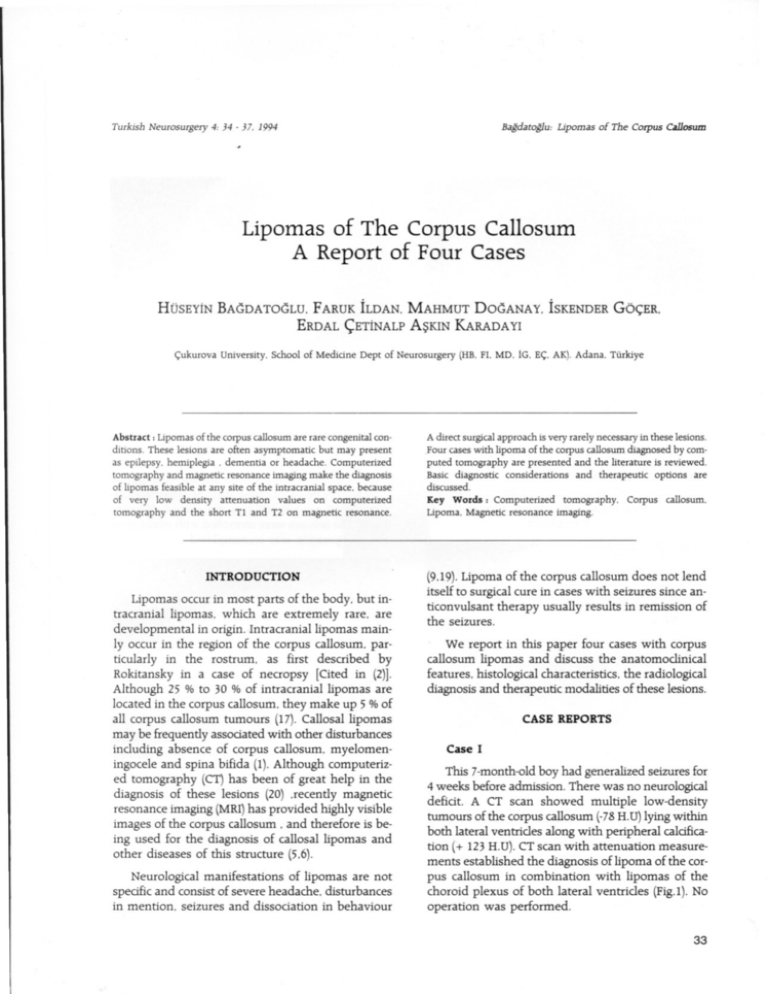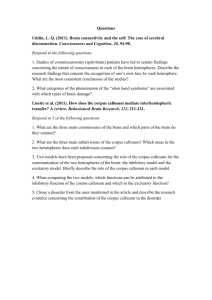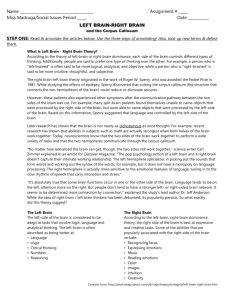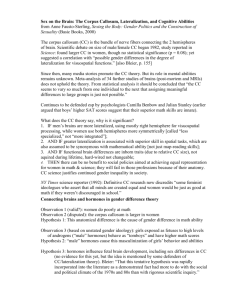Lipomas of The Corpus Callosum A Report of Four Cas es
advertisement

Turkish Neurosurgery 4: 34 - 37. 1994 Bagdatoglu: Lipomas of The Corpus Ca110sum Lipomas of The Corpus Callosum A Report of Four Cas es HÜSEYIN BAGDATOGLU. FARUK ILDAN. MAHMUT DOGANAY. ISKENDER GÖÇER. ERDAL ÇETINALP ASKIN KARADA YI Çukurova University. School of Mediane Dept of Neurosurgery (HB. FI. MD. IG. EÇ. AK). Adana. Türkiye Abstract : Lipomas of the corpus callosum are rare congenital conditions. These lesions are often asymptomatic but may present as epilepsy. hemiplegia . dementia or headache. Computerized tomography and magnetic resonance imaging make the diagnosis of lipomas feasible at any site of the intracranial space. because of very low density attenuation value s on computerized tomography and the short Tl and T2 on magnetic resonance. A direct surgical approach is very rarely necessary in these lesions. Four cases with lipoma of the corpus callosum diagnosed by computed tomography are presented and the literature is reviewed. Basic diagnostic considerations and therapeutic options are discussed. Key Words: Computerized tomography. Corpus callosum. Lipoma. Magnetic resonance imaging. INTRODUCTION (9,i 9). Lipoma of the corpus callosum does not lend itself to surgical cure in cases with seizures since anticonvulsant therapy usually results in remission of the seizures. Lipomas occur in most parts of the body, but intracranial lipomas, which are extremely rare. are developmental in origin. Intracraniallipomas mainly occur in the region of the corpus callosum, particulady in the rostrum, as first described by Rokitansky in a case of necropsy [Cited in (2)). Although 25 % to 30 % of intracraniallipomas are located in the corpus callosum, they make up 5 % of all corpus callosum tumours (i 7). Callasal lipomas may be frequently associated with other disturbances including absence of corpus callosum, myelomeningacele and spina bifida (i). Although computerized tomography (CT) has been of great help in the diagnosis of these lesions (20) ,recently magnetic resonance imaging (MRI)has provided highly visible images of the corpus callosum . and therefore is being used for the diagnosis of callasal lipomas and other diseases of this structure (5,6). Neurological manifestations of lipomas are not specillc and consist of severe headache, disturbances in mentian, seizures and dissociation in behaviour We report in this paper four cases with corpus callosum lipomas and discuss the anatomoclinical features. histological characteristics, the radiological diagnosis and therapeutic modalities of these lesions. CASE REPORTS Case I This 7-month-old boy had generalized seizures for 4 weeks before admissian. There was no neurological deficit. A CT scan showed multiple low-density tumours of the corpus callosum (-78H.U)lying within both lateral ventricles along with peripheral calcillcation (+ i23 H.U). CT scan with attenuation measurements established the diagnosis oflipoma of the corpus callosum in combination with lipomas of the choroid plexus of both lateral ventricles (Fig.i). No operation was performed. 33 Turkish Neurosurgery 4: 34 - 37. 1994 Fig. 1 : Case 1. Combination of lipoma of the corpus ea110sumand lipomas of the choroid plexus of both lateral ventndes. Case II This 60 year old man had complained of headache for one year. A CT sean showed a hypodense lesion (-38 H.U) beginning from the corpus callosum and descending into the right ambient cistem with agenesis of the corpus callosum (Fig.2). No operation was contemplated. Fig. 2: Case ll. Lipoma of the eorpus eallosum deseending to the ambient dsterm. Case III This 36-year-old man had a one year history of occipital headache. Neurological examination revealed no abnormality. CT sean showed regular low density (-55 H. U.) involving the corpus callosum from the genu through the body into the splenium (Fig.3). This lesion was presumed to be alipoma due to attenuation measurements and no operation was performed. 34 Bagdatoglu: Lipomas of The Corpus Callosum Fig. 3: Case 111. Axial CT sean showing a low hypodense lesion involving the eorpus ea110sumfrom genu through the body into the splenium. Cas e LV This 3-year-old boy suddenly complained of headache. nausea and vomiting for two days before admission and seizures beginning one year ago. A CT sean revealed a lobulated mass of extremely low density (-90 to -110 H.U.) in the corpus callosum (FigA). The seizures were controlled with medication and no operation was contemplated. Fig. 4: Case IV. Large lobulated lipoma in the eorpus eallosum. DlSCUSSION Most authors have hypothesized that intraaaniai lipomas originate from fat cells present in the leptomeninges or primitive pial cells due to maldevelopment (15).This theory is supported by Mattem et al (13) since the common location of lipomas in some cistemal space which has a much amount of leptomeninges and these regions correspond to the site of flexion of neural tube. Bagdatoglu: Lipomas of The Corpus Callosum Turkish Neuwsurgery 4: 34 - 37, 1994 Intracranial lipomas are most frequently located in the region of corpus callosum since they often arise from the midline cerebral astems. particularly the callosal astem (3.18). Other common locations are the region of the ambient astem. the tuber dnereum and th quadrigeminal plate (7.10). Lipomas of the lateral cistems are extremely rare and a few cases have been described in the cerebellopontine angle (8.16) or in the sylvian fissure (4.11). In the pre-CT era. intracranial lipomas were rarely encountered . Peripheral caleification of lipoma in plain skull x-rays are reported to be diagnostic (18). but were nonspeeific in all our cases. This entity was more often diagnosed during the life time of the patient by the clinicians with the advent of CT scanning. Recently MRI provides highly visible images of the intracranial lipoma particularly for the callosal lipomas (1.5).The CT characteristics oflipomas of the corpus callosum were first described by Newand Scott (14) in 1975. A homogeneous low density area with attenuation values between -60 and -200 H.U. no contrast enhancement. regular margins and often linear caleifications in the surrounding area are the main characteristics of this lesion on CT scan. Although the CT attenuation values of fatty tissue ranged between -38 and -1l0 H.U. in our series. density of the lesion in the second and third cases which was -38 and -55 H.U. respectively. was considered to be due to the partial volum e effect of peripheral neural tissue around the tumour. as reported by Kazner (12). This partial volum e effect generally occurs in lipomas smaller than 25-30 mm in diameter. Intracranial lipomas commonly show short Tl and T2 with high intensity region s in Tl-weighted and a decrease in T2-weighted images. MRI is a procedure of choice in the evaluation of corpus callosum lipomas for its capacity to obtain direct coronal images without reconstruction (1.5). Furthermore MR signals for lipomas are specific and usually allow a correct diagnosis. In the differential diagnosis of these lesions. lesions with a fatty component. such as epidermoid cysts. dermoid cysts. teratomas. myelolipomas. angiolipomas should be considered. Dermoid cysts usually present as less homogeneous lesions on CT (12) and MR1 (15) since they tend to show caleification and contain hairs in the cyst. Epidermoid cysts contain a high degree of keratin crystals and usally show low attenuation values mimicking those of CSF on CT scan. Finally. teratomas which contain various type of tissue such as adipose. cartilage. muscle and bone would therefore vary in both CT attenuation and MRI relaxation parameters. Lipomas of choroid plexus combined with lipoma of the corpus callosum similar to the first case in our series were frequently mentioned in the early neuropathological literature (12). Although most intracranial lipomas are asymptomatic and are diagnosed during neuroradiological investigations. some patients have neurological symptoms. Callosal lipomas show clinical presentation in alinost half of the cases. In symptomatic cases. the most common symptom is epileptic seizure (50-60 %) which can be attributed to interhemispheric disconnection (9).Epilepsy observed in the first and fourth cases in our series was probably due to such a disconnection. Some patients may show mental deficiencyand slightly psychic retardation due to associated malformations such as callosal agenesis or hemispheric atrophy. The occurrence of focal neurological signs is exceptional and limited to some callosal lipomas with hemiparesis. A direct surgical approach is rarely indicated in callosal lipomas. since theyare slow-growing lesions and rarely reach a size sufficient to cause a mass effect. Complete removal of the lesion in this location is almost impossible because of the firm adhesions between the collagenous capsule and the brain and the high vascularity of the tumour. Furthermore. the close relationship of the anterior cerebral arteries to the lesion is another important difficulty for surgery. Surgical management of hydrocephalus may be necessary if pressure symptoms or progressive dementia are present, We believe that the surgical indications for removal of a lipoma of the corpus callosum should be carefully and cautiously considered since it is a benign. slow growing lesion. most patients are asymptomatic and epilepsy .which is the commonest symptom that can not be cured by surgery. Correspondance: Dr. Hüseyin Çukurova Department Bagdatoglu University Faculty of Mediane of Neurosurgery Balcali, Adana - Türkiye Phone: 324 - 338 60 60 35 Turkish Neurosurgery 4: 34 - 37. 1994 Bagdatoglu: Lipomas of The Corpus Callosum REFERENCES i. Atlas SW. Zimmerman RA .. Bilaniuk LT: Corpus eallosum limbie system:neuroanatomie tal anomalies. 10. Halmagyi GM. Evans WA: Lipomas Radiology MR evaluation 160:355-362.1986 lipomatous hamartomas a study of 13 eases including medulloblastoma. and other malformations. by ultrasound 18:409-410.1988 and magnetie RB. Segal R. Latehaw resonance RE: Computerized and magnetie resonance imaging Neurosurg 65:407-410.1986 7. Friede 1, Osteolipomas Med 101:369-372.1977 8 Fukui M. Tonaka eerebellopontine 46:544-547.1977 of the tu ber cinereum. A. Kitamura angle K. Okudera Case 9. Gastaut H. Regis H. Gastaut JL. Yermenos lipoma 16. Rosenbloom J Areh Path Lab of the J Neurosurg E. Low MD: Lipomas of the corpus callosum and epilepsy Neurology 30: 132-138.1 980 Baltimore: SB. Steiner RE.Bydder aging of intraeranial 5:703-709.1984 Radiol T: Lipoma report 15. Peterman tomographie of intraeranial S. Grumme T: Diagnostie J.Neurosurg Wc. Blattner ER. Werth J. Shuman Orbit (EMI Seanning). 397 diagnosis Pediatr of the insula . Case 1983 O . Wende considerations. 14. New PFJ. Scott WR: Computed Case plate Case report J 52:234-245.1 980 R. Bloch S. Leibrock L: Eighth nerve lipoma. Case report J Neurosurg 28:205-22.1974 hallucinations. T. Ishii S: Lipoma J Neurosurg58:300-302. 13 Mattem with of the quadrigeminal hydroeephalus. 49:453-456.1 978 S. Sakakibara and therapeutie eysts . angiomatosis Aeta Neuropathol obstruetive 12. Kazner E. Stoehdorph (Intraeranial report. Neurosurgery 16:64-66.1985 5. Fisher RM. Cremin BJ: Lipomas of co rp us eallosum: 36 report tumors. combinations colloid and epidermoid 4. Dyck P: Sylvian lipoma eausing auditory 6. Fridman Neurosurg ll. Hatashita 15:15-54.1931 3. Budka H: Intracranial "lipomas"): and of developmen- 2. Bailey P. Buey PC: The origin and nature of meningeal Am J Caneer eausing progressive tomography Williams SB.Carson and Wilkins. GM: Magnetie tumors in children BM. Wang varhelyi GB: Cerebellopontine 23:134-138.1985 53:397-400.1 980 of the Brain and resonance and adoleseents. H. Rosenbaum angle 1975: lipoma. imAJNR AE. Vd- Surg Neurol 17. Russel DS. Rubinstein LJ: Pathology of Tumours of the Nervous System. ed 3 London: Edward Amold. 1971:25 18. Tahmouresie A. Kroll G~ Shueart W: Lipoma eallosum. Surg Neurol II :31-34.1 979 19. Wallaee D: Lipoma of the eorpus callosum. Psyehiatr 20. Zimmerman of the corpus J Neurol Neurosurg 39: II 79- 1185.1 976 RA. Bilaniuk IT.Dolinskas c: Cranial eomputed tomography of epidermoid and eongenital maldevelopmental origin. CT 3:40-50.1979 fatty tumors of







